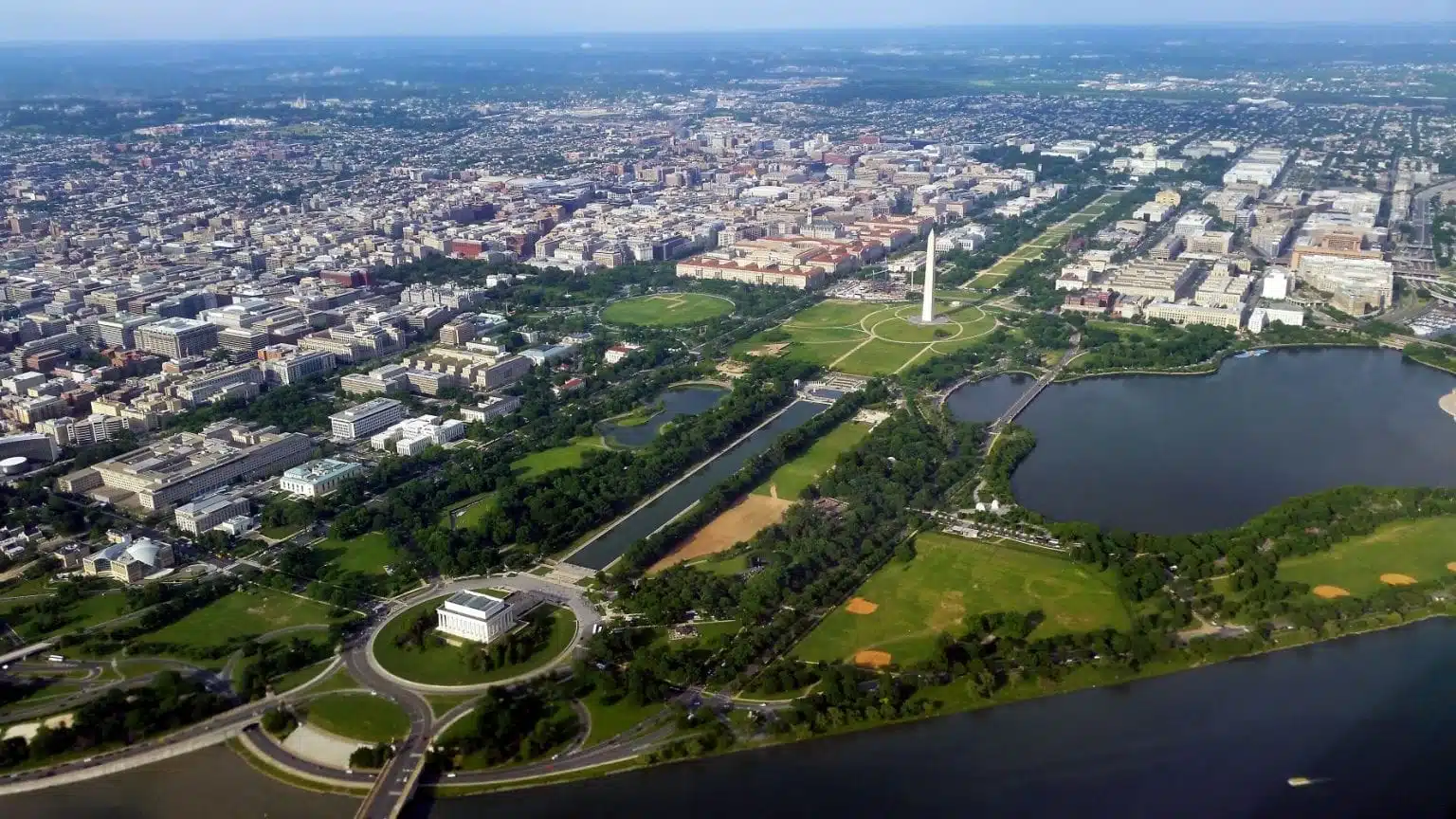
DC Neighborhoods and Suburbs You Need to Know: Your Guide to Life in the Capital City
Washington DC Virginia Maryland
Thinking about moving to the nation’s capital? Besides being at the seat of power, the city is home to an expansive collection of diverse Washington, DC, neighborhoods and surrounding DC suburbs that offer compelling choices for singles, young professionals, and families alike. From all the options, selecting the best neighborhoods in DC depends on your personal taste. And if you’re moving long-distance, be prepared to expand your search to include the best neighborhoods in the DC metro area (aka the DMV), from Maryland to Northern Virginia suburbs, in addition to DC neighborhoods. Don’t worry — you won’t be going too far. When living in DC, you often end up crossing state lines without even noticing.
| Planning a move to Washington, D.C.? Start by getting a quote from PODS. |
DC Neighborhoods and Suburbs — FAQs
Q: What suburbs are close to DC?
A: Given that the DMV area encompasses parts of Maryland and Virginia, some of the DC suburbs closest to the capital city are Silver Spring, MD; Bethesda, MD; and Arlington, VA.
Q: Where is the best place to live near Washington, DC?
A: Niche ranks North Potomac, Maryland, as the best DC suburb to live overall. Though if you're looking for the best suburbs of DC to raise a family, take a look at Bethesda (ranked No. 6 in the state of Maryland), and Fulton, MD (No. 3), as well.
Q: What are the Washington, DC, neighborhoods?
A: There are several dozen DC neighborhoods that make up the four quadrants — too many to list here. Among the best neighborhoods around DC, though, are Adams Morgan, Capitol Hill, Glover Park, and Logan Circle.
Q: What is the nicest part of DC?
A: Situated in the northwestern quadrant of Washington, DC, Colonial Village is a family-friendly and walkable area that is ranked as the No. 1 best DC neighborhood to live in by Niche. Mount Pleasant, one of our top picks, is also in Niche’s top 10.
Q: Where is it affordable to live in DC?
A: The cheapest DC neighborhood for you depends on factors like whether you’re renting or buying, where you’re commuting to and from, and what you like to do for fun. That said, in Fairfax Village (ranked the No. 1 neighborhood with the lowest cost of living in DC), most residents own their homes, but the average rent for a one-bedroom apartment is around $1,525. Similarly, Glover Park — one of our top picks on this list — has an average monthly rent of around $1,975 for a one-bedroom apartment. Compare that to the average city-wide rent of around $2,500, and these DC neighborhoods start to feel quite affordable.
Q: What is the richest area to live in DC?
A: The Northwest quadrant of the District is generally considered the richest area, based on housing values and income averages. In the West End neighborhood, for example, renters pay the highest monthly costs in the DMV, with the average one-bedroom going for $3,775. Home costs are similarly near the stratosphere (relatively speaking) at an average $702,400. And the area has incomes to match, with 40 percent of its residents earning $150,000 or more. You’ll find the very highest home prices in the quadrant — and in the city — in Kent, where the average runs a cool $2 million.
Q: What is the roughest neighborhood in DC?
A: While Washington, DC, has a crime index of 2 (meaning it’s considered safer than just 2 percent of other U.S. cities), there are plenty of areas to live where residents consider themselves secure — it’s a city known for national security, after all. If you’re looking for the safest neighborhoods in DC, though, avoid Deanwood — an area that experiences 175 percent more crime than the rest of the city, per AreaVibes.
Q: What is the coolest neighborhood in DC?
A: U Street sets a high bar for the cool factor in DC neighborhoods. The center of nightlife and culture for the Black community in the early 1900s, the area today is a diverse, welcoming hub for families and young professionals who enjoy jazz and the arts. The legendary Howard Theater and JoJo Restaurant and Bar (with live jazz and blues) are just two of the highlights that make this one of the best places to live in DC.
| Moving to D.C. from outside the area? Jump to the sections below for a quick look at average moving costs: Raleigh, NC to Washington, D.C. Boston, MA to Washington, D.C. |
Map of Washington, DC, Neighborhoods
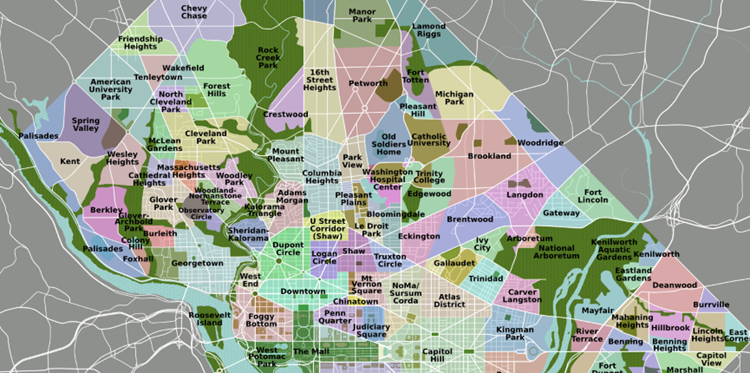
The city’s NW quadrant is home to many of the best DC, neighborhoods.
(Source:Peterfitzgerald, CC BY 3.0, via Wikimedia Commons)
Exploring DC Neighborhoods: The District
So are you wondering: Is Washington, DC, a good place to live? If you’re looking at a DMV area map, you’ll find Washington, DC, is at the heart of it. Although DC is divided into four quadrants — Northwest (NW), Northeast (NE), Southwest (SW), and Southeast (SE) — about half of the city’s population lives in the Northwest section, which also covers 42 percent of the total land area. Southwest is the smallest quadrant and is dominated by the Joint Base Anacostia-Bolling military installation.
Northwest includes the downtown business district, the 10 government buildings included in the Federal Triangle complex, the museums along the northern side of the National Mall, and the White House. Considering all that critical mass, it’s no surprise that the DC neighborhoods most in demand are also located in the Northwest.
Here’s a quick snapshot of Washington, DC, neighborhoods to consider.
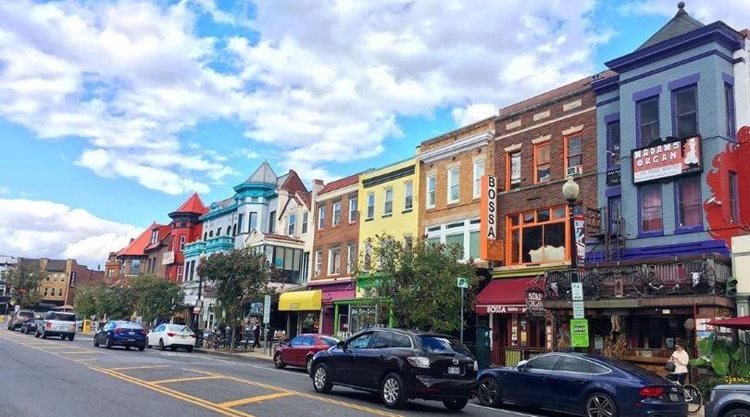
A colorful row of buildings line a street in Adams Morgan — one of the best neighborhoods in Washington, DC.
(Source: @visitwashdc via Instagram)
1. Adams Morgan (NW)
- Average rent (one-bedroom): $2,550
- Average home value: $581,500
- Great for: Families, outdoor activities, nightlife, commuting
- Nearest metro station: Red Line stations Woodley Park and DuPont Circle are each about a mile away.
2. U Street Corridor (NW)
- Average rent (one-bedroom): $1,750
- Average home value: $633,100
- Great for: Arts, nightlife, diversity, commuting
- Nearest metro station: U Street/African-American Civil War Memorial/Cardozo Station serves the Green Line.
Historic row houses and new contemporary condos are the hallmarks of the U Street neighborhood in terms of housing. When it comes to the arts and entertainment, though, this district is all about nightlife and its rich, storied history as “Black Broadway.” Home to Duke Ellington, U Street was the DC hub of Black culture and music in the early 20th century — and later, to iconic venues like the 9:30 Club (and its original pre-1980 incarnation, The Atlantis, still on the property). Today the district welcomes residents and visitors to one of the most lively, culturally diverse areas of all DC neighborhoods. As for food, nobody skips Ben’s Chili Bowl, a legendary staple since 1958 for the “half-smoke,” the one-of-a-kind DC hot dog, and chili.
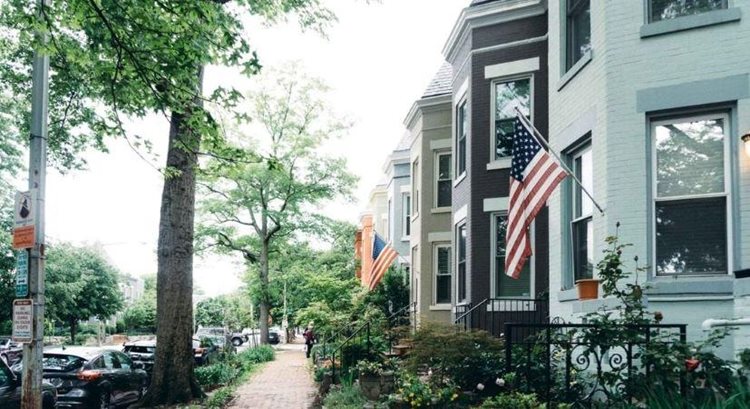
In addition to being home to the U.S. Capitol building, the Capitol Hill neighborhood features several parks and blocks of row houses, townhouses, manors, and Queen Anne homes.
(Source: @buchananparkwdc via Instagram)
3. Capitol Hill (NE and SE)
- Average rent (one-bedroom): $3,050
- Average home value: $930,800
- Great for: Families, outdoor activities, nightlife, diversity, commuting
- Nearest metro station: Capitol South and Eastern Market Stations serve the Orange, Silver, and Blue Lines.
The Capitol Hill neighborhood of DC does indeed contain the U.S. Capitol Building, which sits on its Western border, with the rest of the district fanning out east to Lincoln Park. The area also includes several parks, such as Stanton, Folger, Marion, Garfield, and Seward Square, as well as the Supreme Court of the United States and the Library of Congress — after all, this is Washington, DC — a nice place to live, but also the seat of global power. Beyond the iconic government institutions, Capitol Hill is largely residential, with blocks of row houses, townhouses, manors, and Queen Anne homes. Crosscutting Pennsylvania Avenue is the commercial corridor, with a number of trendy shops, cafes, bars, friendly restaurants, and Eastern Market, one of the most popular weekend hubs among DC neighborhoods for fresh produce and more.
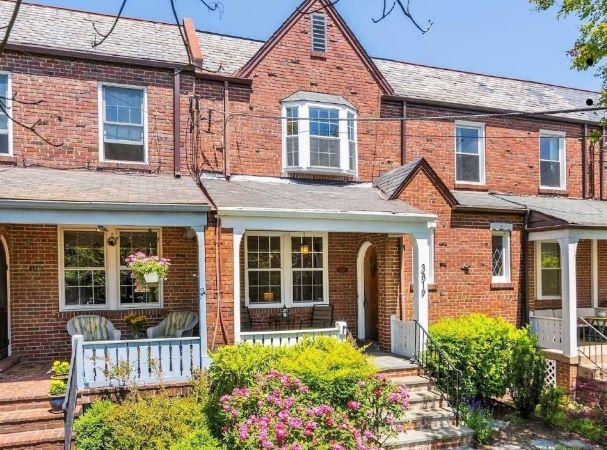
Glover Park residents have plenty of townhomes and apartments to choose from, as well as easy access to parks, retail, and casual eateries.
(Source: @petersellsdc via Instagram)
4. Glover Park (NW)
- Average rent (one-bedroom): $1,975
- Average home value: $589,000
- Great for: Public schools, families, outdoor activities, nightlife, commuting
- Nearest metro station: The Red Line station Cleveland Park (near the National Zoo) is about two miles away.
An upscale, leafy-green neighborhood, Glover Park is tucked away just west of Number One Observatory Circle (the site of the Vice President’s home). And like many DC neighborhoods, Glover Park is also home to several official sites — like the Russian Embassy and its infamous underground tunnels. For non-diplomatic residents, Glover Park is filled with row houses and apartment buildings, lined by Glover-Archibald and Whitehaven Parks, with a commercial corridor along Wisconsin Avenue offering casual eateries and service retail.
5. Navy Yard (SE)
- Average rent (one-bedroom): $2,850
- Average home value: $642,900
- Great for: Families, outdoor activities, nightlife, commuting
- Nearest metro station: Navy Yard-Ballpark Station serves the Green Line.
Once a shipbuilding hub of warehouses and other industrial sites, Navy Yard has transformed into one of the most dynamic of all DC neighborhoods. Bookended by Nationals Park (home base for DC’s MLB team — and a major catalyst for the neighborhood’s renaissance) and the Anacostia Riverwalk Trail (a jewel of the National Park System), this waterfront area is terrific for young professionals and families. Single-family homes are somewhat rare, but upscale, high-rise, amenity-filled condos like Azure National Landing are plentiful. And who can resist views of Nationals Park on a summer night?
Dining, in particular, is a major attraction, with a true restaurant boom underway in the last few years. Among the buzziest is Albi, a lovely spot for delicious and innovative Middle Eastern cuisine, but call ahead — reservations are running about a month out.
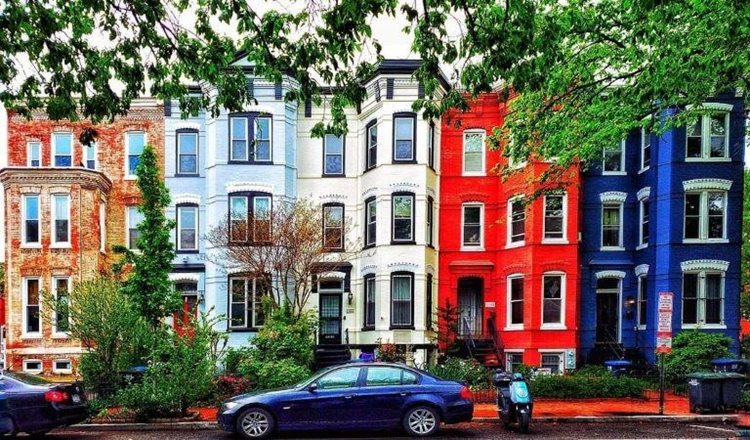
The Logan Circle neighborhood is popular among hipsters and young professionals of the LGBTQ+ community. Residents have easy access to downtown, though they likely have to contend with traffic more often than not.
(Source: @visitwashingtondc via Instagram)
6. Logan Circle (NW)
- Average rent (one-bedroom): $2,575
- Average home value: $592,900
- Great for: Families, outdoor activities, nightlife, diversity, commuting
- Nearest metro station: Shaw-Howard and Mt. Vernon Square on the Green Line are just to the east.
Like its neighbor DuPont Circle, Logan Circle may be best known as either a gem among DC neighborhoods or a traffic circle, depending on your point of view. Jokes aside, the neighborhood is particularly popular among hipsters and young LGBTQ+ professionals. Just northeast of downtown and the Washington Mall, Logan Circle is walkable to downtown and just a 5-minute bus ride. It features a variety of boutiques (check out Salt & Sundry), restaurants (peep this guide to Logan Circle eateries), galleries, clubs, gay bars (don’t miss Number Nine), and theaters, along with a popular Whole Foods location.
Map of D.C. Suburbs in Maryland
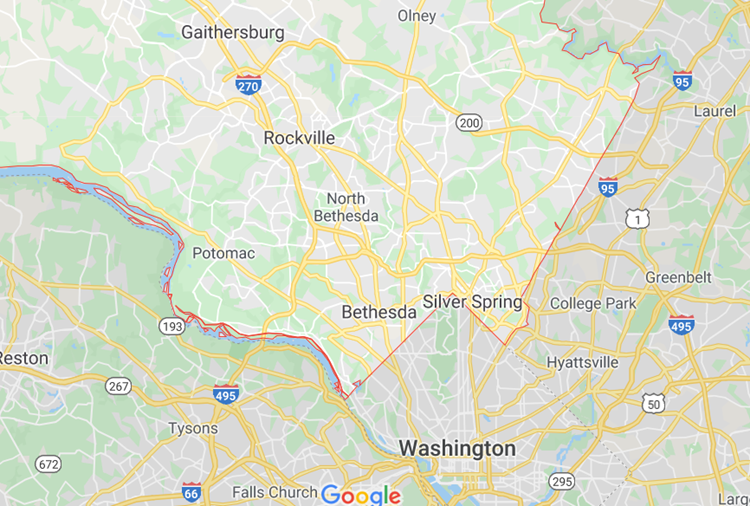
Some of the best DC suburbs are located in Maryland.
(Source: Google Maps)
Washington, DC, Suburbs in Maryland
When looking for the best places to live in DC, in some cases, the answer may actually be slightly outside the city. Don’t sleep on some of the best cities in Maryland near DC — from Silver Spring to Rockville.
1. Silver Spring, MD
- Average rent (one-bedroom): $1,950
- Average home value: $551,100
- Great for: Public schools, families, outdoor activities, nightlife, diversity
- Nearest metro station: Silver Spring features three stations on the Red Line.
Looking for the best neighborhoods near DC? In the southeast corner of Montgomery County, Silver Spring sits atop the point of DC’s geographic diamond. A favorite of both locals and visitors, downtown Silver Spring includes a large outdoor shopping plaza featuring several upscale national stores, surrounded by an inviting neighborhood designed for strolling, with a variety of family-owned ethnic restaurants and interesting shops. Major draws include the American Film Institute’s Silver Theatre and Cultural Center, the Ellsworth Place enclosed mall, and the 2,000-capacity Fillmore Silver Spring music venue.
Plenty of apartment and condominium buildings are tucked within this compact community, while more traditional suburban homes spread out from the center. As a result, Silver Spring offers a wider range of affordable to expensive options than many other DC neighborhoods, making it among the best places to live in Maryland for young adults.
| Need help planning your move to DC? Check out these articles from the PODS Blog: |

Downtown Bethesda features pedestrian streets and many outdoor dining opportunities.
(Source: @BethesdaUP via Facebook)
2. Bethesda, MD
- Average rent (one-bedroom): $2,750
- Average home value: $1.1 million
- Great for: Public schools, families, outdoor activities, nightlife, commuting
- Nearest metro station: Grosvenor-Strathmore and Bethesda Stations sit along the Red Line.
If you’re searching “best neighborhoods in the DMV area,” you’re bound to see Bethesda near the top of most lists. This Montgomery County suburb along the northwest DC border is centered around a bustling, highly walkable downtown area near the Metro station, where there’s an eclectic mix of restaurants and boutiques, condos, and apartment buildings. From there, Bethesda fans out into DC suburbs with stately homes and plenty of green space, in addition to the Congressional Country Club, which has hosted five major golf championships.
And while plenty of Bethesda residents commute into DC, many work in one of the leading healthcare facilities located here. Not only is Bethesda the center of healthcare in the DC area, but it may also be considered the nation’s capital of medicine. It’s home to the National Institutes of Health (NIH), Walter Reed National Military Medical Center, Uniformed Services University, National Library of Medicine (part of NIH), and the dozens of medical contractors and facilities that have sprung up around them.

Renters and homebuyers will find a dollar goes further in Rockville, making it easier to afford a home for a growing family.
3. Rockville, MD
- Average rent (one-bedroom): $2,350
- Average home value: $635,100
- Great for: Public schools, families, outdoor activities, nightlife, diversity
- Nearest metro station: Rockville offers two Red Line stations.
Farther out from interior DC neighborhoods than Bethesda and Silver Spring, the city of Rockville has a more suburban feel than its neighbors. But while its downtown may not match those communities in convenience and charm, Rockville is a major business and technology center. Many software and biotech companies offer quality jobs for those who want to live and work in the same community. It’s also the setting for an R.E.M. classic — and not many burbs can boast that honor!
With a little distance, renters and homebuyers will find a dollar goes further in Rockville, too, making it one of the best suburbs of DC to raise a family. Families have more room to grow, with larger homes and lots, but there’s also a good mix of condominiums and apartment complexes, especially in the area of Rockville Town Square, a major mall with more than 20 dining options.
Map of Arlington County, Virginia
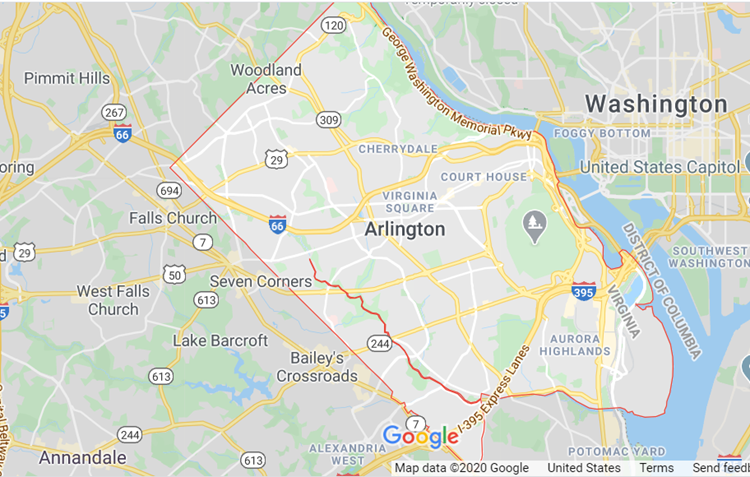
Across the river from some of the best DC neighborhoods you’ll find some great DC suburbs in Northern Virginia.
(Source: Google Maps)
Washington, DC, Suburbs in Northern Virginia
Just across the Potomac River from the lovely DC neighborhoods, Northern Virginia is home to many covetable suburbs, too. Whether you’re looking for the best DC suburbs for public schools or a neighborhood situated near Fort Belvoir, you can find it in one of these Virginia suburbs.
1. Arlington, VA
- Average rent (one-bedroom): $2,650
- Average home value: $826,100
- Great for: Public schools, families, outdoor activities, nightlife, diversity, commuting
- Nearest metro station: There are 11 Metro stops in Arlington along the Blue, Orange, Silver, and Yellow Lines.
Formerly the southwest portion of the District of Columbia, Arlington is actually an unincorporated city that makes up all of Arlington County. Home to the Pentagon and Reagan National Airport, Arlington offers a lot of convenience, starting with the Rosslyn area located just across the Potomac River from Georgetown. From there, Arlington spans out into nearly 60 distinct neighborhoods.
Arlington neighborhoods, like DC neighborhoods, are diverse — from idyllic but pricey Old Glebe in the northwest corner to the more affordable but up-and-coming Shirlington in the southeast corner. There’s also a broad mix of housing types, ranging from Rosslyn’s high-rise condominiums and apartment buildings to colonial-style, single-family homes and townhouses in neighborhoods like Ashton Heights and Columbia Pike.
And while a majority of Arlington residents commute to work, vibrant downtown areas in the Clarendon, Rosslyn, Virginia Square, and Ballston districts offer plenty to keep folks in town after hours. A great way to explore Arlington’s green spaces is by biking or walking the county’s nearly 49 miles of paved trails and visiting one of the 191 parks, nature centers, or community centers.
Map of Fairfax County, Virginia

From chocolate festivals to book fairs, Fairfax has something for everyone — plus, it’s one of the best DC suburbs for young professionals.
(Source: Google Maps)
2. Fairfax, VA
- Average rent (one-bedroom): $2,375
- Average home value: $783,000
- Great for: Young professionals, families, jobs, outdoor activities, nightlife, diversity
- Nearest metro station: Vienna-Fairfax-George Mason on the Orange Line is the only station in Fairfax City
When you hear about Fairfax, Virginia, it’s easy to get confused between the city of Fairfax and Fairfax County. While the city of Fairfax is also the Fairfax County seat, the enclave is a separate entity dating back to 1805. Close enough to DC to feel integral to the DMV area but distant enough to exude a deep suburban vibe, Fairfax is ranked among the best suburbs in Virginia for young professionals by Niche. But it’s not all work in Fairfax, with popular events like the Chocolate Lovers Festival, Spotlight on the Arts, and Fall for the Book Festival.
| There’s more to Fairfax County than Fairfax. Moving beyond Fairfax city proper, Fairfax County encompasses a large portion of Northern Virginia, with a population of more than 1.1 million residents. A study in contrast, Fairfax is home to the storied history of George Washington’s Mount Vernon as well as Tysons Corner Center, a massive, modern shopping and office complex. In between are comfortable communities that invite families — a mix of suburban neighborhoods with top-rated schools and urban-style retail cores, including:
|

Springfield residents enjoy hiking, biking, picnicking, and horseback riding at Brookfield Park and Lake Accotink Park (pictured).
(Source: Visit Fairfax via Facebook)
3. Springfield, VA
- Average rent (one-bedroom): $2,250
- Average home value: $710,600
- Great for: Families, outdoor activities, diversity
- Nearest metro station: Franconia-Springfield station is the southwestern terminus of the Blue Line.
In addition to being close enough to commute to DC jobs, Springfield is home to three major federal employers — the National Geospatial-Intelligence Agency (NGA), Fort Belvoir Army base, and the recently completed Transportation Security Administration (TSA) headquarters. Springfield Town Center, newly renovated to incorporate more outdoor foot traffic, offers plenty of shopping and dining options. Residents enjoy hiking, biking, picnicking, and horseback riding at Brookfield Park and Lake Accotink Park.
Cost To Move Long-Distance to Washington, DC
Long-distance moving costs depend on various factors. The most important are the distance being traveled, the amount of stuff you’re moving, the time of year, market conditions in the city you’re leaving, and even the direction of your move. In general, it will cost you less to move northward from the south because there’s not as much demand for moving in that direction.
To give you an idea of the cost to move cross-country, let’s look at moving estimates from LA to DC. Renting a moving truck will cost between $1,757 and $4,053 for a 2- to 3-bedroom household, but that depends on the truck’s size and your precise location — and that doesn’t include fuel costs. The same move costs between $5,037 and $6,857 for a PODS portable moving container. And for a full-service move? Expect to pay from $4,551 to $8,972 (or more) to have professional movers load and transport your things from the West Coast to DC.
As you’re exploring places to live in DC, it’s not too soon to start planning your move. Here are some average moving costs for shorter distances to give you a general idea of what to expect. Bear in mind that these are rough estimates, so be sure to get detailed quotes for your specific move.

Relocating from Raleigh, NC, to Washington, DC, could cost anywhere from $376 to upwards of $4,600, depending on the moving service you choose.
(Source: Google Maps)
Moving From Raleigh, NC, to Washington, DC (278 miles)
Your costs will vary, depending on how much stuff you have to move and the season, but here are some useful reference points. Relocating a 2- to 3-bedroom household from Raleigh, NC, to DC will cost between $376 and $698 for a rental truck (not including fuel), $1,666 and $4,611 for a professional moving company, or from $1,927 to $2,870 with a PODS portable moving container.

If you’re moving from Boston to Washington, DC, your cheapest option will likely be renting a truck, though a PODS moving container can offer a more flexible move.
(Source: Google Maps
Moving From Boston, MA, to Washington, D.C. (440 miles)
Relocating the contents of a 2- to 3-bedroom home from Boston to DC will cost between $464 and $941 for a rental truck (not including fuel costs), $2,055 and $5,851 for professional movers, or $2,307 to $3,416 with a PODS moving container, which has storage options built in. However, the time of year and size of your move will impact your final moving costs.
| Pro Tip: Check out our DC Moving Guide to learn more about your moving options (including pros and cons) and manage the details with these tips on moving out of state. |
When it comes to moving, the important thing is to know your options, choose the type of service that meets your needs, and select a reliable company that delivers great service. When you move with PODS, a container is delivered to your driveway for convenient packing and loading, then picked up and transported to your new home. PODS City Service is also available in DC, for those who’d like to streamline the process of moving into a big city. And if you need to store your container at any point during your move, that’s an option as well.
Michael Hochman is currently working as a lifestyle and travel writer for Apartment Guide and rent.com.
Editor’s note: Moving estimates for professional movers and rental trucks were obtained from movebuddha.com. Average and median rent prices were obtained from RentCafe, Zumper, and Zillow; average home values were obtained from Zillow; and median home sale prices were obtained from Redfin. For ease of reading, monthly rental prices were rounded to the nearest $25 and home values were rounded to the nearest $100.
Related Articles
Comments
Leave a Comment
Your email address will not be published. Required fields are marked *
